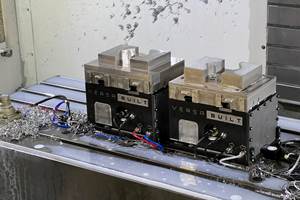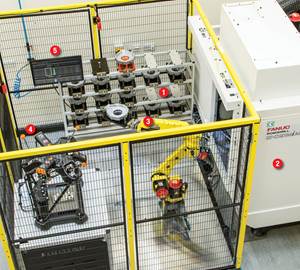Vertical Integration, Automation Helping 3D Printed Spine Implant Manufacturer Scale Production
How did a leading spine implant manufacturer leverage 3D printing to compete on cost with CNC machining? Learn how advanced additive manufacturing techniques are redefining material efficiency and geometric complexity in medical devices.
Share





When Tangible Solutions launched just over a decade ago, the founders anticipated that there would be demand for additive manufactured spine implants largely for their design possibilities. Design is still a driver for adoption (including engineered surface roughness as shown here in nTop) but these days, Marle Tangible is much more likely to win based on cost. Source: Additive Manufacturing Media
“Additive manufacturing can’t be a cornerstone of manufacturing unless it’s profitable,” says Adam Clark, CEO of Marle Tangible, a 3D printed medical device manufacturer located in Fairborn, Ohio.
When Clark cofounded this business in 2013 under the name Tangible Solutions, he and business partner Chris Collins saw a particular path to that profitability in the production of titanium spine implants: intricate, complex geometries that would provide sufficient biomedical advantages to justify a higher price tag than conventionally machined implants.
The company grew under this premise, becoming specialized and successful at using laser powder bed fusion (LPBF) to manufacture these implants in production, eventually being acquired by French medical device contractor Marle in 2022. Today Marle Tangible produces more than 50,000 3D printed implants at its Ohio site per year. The company is still profitable, but for slightly different reasons: AM spine implants are no longer always the more expensive option. In fact, in many cases Marle Tangible finds that its prices are similar or even lower than conventional implants made via machining.
“The clinical advances of 3D printed implants drove adoption initially,” Clark says, “but now cost is becoming the differentiator. I never thought we’d be competing strictly on price.”
Much has changed in additive manufacturing technology in the last decade, but the shift this company has seen is not due to upgrading 3D printers or adopting new machines. At Marle Tangible, today’s implants are made on the same Concept Laser (now-GE/Colibrium Additive) LPBF platform that the company started with, and titanium powder is still the material of choice. The reasons for cost competitiveness instead have more to do with the company’s years of expertise and learning to streamline operations, Clark says.
As we walked through the facility on my recent visit in January, passing through the fleet of 12 metal 3D printers, between twin wire EDMs, and down an aisle of six CNC mills toward the manual deburring station at the back of the building, Clark told me that many of the refinements to the AM process over the years have been to limit and reduce the amount of time that any part spends in this last station, receiving manual deburring attention.
Minimizing this handwork step starts all the way back at part design and build setup. Although Marle Tangible does not design implants internally, it does provide feedback and assistance to customers to make sure their implants have been optimized for 3D printing as well as downstream processing — which includes looking for ways to minimize and avoid support structures, and therefore deburring work, whenever possible.
Almost all steps of the additive manufacturing process are found within Marle Tangible’s Fairborn, Ohio, facility. Parts are printed near the front of the building, and then progress through postprocessing steps including wire EDM cut-off, machining, laser marking, passivation and machining, with hand deburring as one of the last steps. Source: Additive Manufacturing Media
Here are some other ways that the workflow has become streamlined:
Marle Tangible has added two passivation lines to its shop floor in an effort to bring even more of the additive workflow in house. In-sourced processes like this help the company meet faster deadlines and prevent mishaps that can happen when shipping parts to outside suppliers. Source: Marle Tangible
- Efficient Batching. “We have to charge customers based on their parts’ real estate in the machines,” Clark explains. A batch of implants that doesn’t fully cover the plate will end up being more expensive per part than one that does, because the same amount of powder must be used to fill the build volume and the time to print will be the same. This more nuanced approach to pricing (per build rather than per part) helps protect the manufacturer’s time and resources, and in some cases, may encourage the customer to order based on manufacturing batches rather than a flat quantity.
- Material Recycling. Titanium powder is a necessary investment to keep the printers running, but it is difficult if not impossible to use 100% of the powder purchased because it will degrade over time with exposure to oxygen. Previously old, out-of-spec powder might have been scrapped for a small amount of money, but today Marle Tangible sends its spent powder to materials manufacturer and processor 6K Additive so that it can be refreshed for future use in additive manufacturing. The implant manufacturer has less material waste, and can recoup more of the investment that it makes in titanium powder.
- In-House Passivation. Two passivation lines are a newer addition to the Marle Tangible shop floor, used to clean the implants and impart a layer of protective oxide. In the past, implants had to be shipped out to a supplier for this step, which could cause delays — and in one extreme instance, the loss of a batch of parts by the shipping company. The shipment was insured, but recovering the cost of the parts still left the customer without a product until they could be remade. Bringing passivation in house (and potentially other steps in the future) gives the implant manufacturer greater control over its process, which in turn can mean faster lead times as well.
Growing Pains
Despite its acquisition by Marle Group three years ago, Marle Tangible today still operates relatively independently within its parent organization. However, the relationship has brought greater access to suppliers and resources within Marle’s overall network. In the past, for example, Tangible Solutions worked with a handful of different suppliers for hot isostatic pressing (HIP); now, it can access this service through Marle instead, bringing more predictability to the manufacturing process.
Another example of how the parent company relationship has bolstered Marle Tangible was playing out on my recent visit. One of the company’s machining cells was in the process of being automated for unattended and lights-out postprocessing of spine implants. Thus far, the five-axis Hurco CNC mill had been equipped with automated clamping capability to reduce the amount of setup required by the operator.
Today, Marle Tangible’s six five-axis mills from Hurco are loaded and unloaded by hand; soon the company plans to automate at least one of its machining cells with a robot that can perform this work autonomously, opening the door to lights-out postprocessing. Source: Additive Manufacturing Media
A robot that can load and unload these parts will be added soon; at the time of my visit, Marle engineers in France were in the process of working out the automation, before sending the solution on to Tangible. Being part of this larger network of engineering expertise and manufacturing resources has helped the additive manufacturer run farther and faster than it might have on its own.
Isaac Talley, engineering manager, explains the job currently running in one of Marle Tangible’s LPBF machines. All of the company’s current printers are Concept Laser/GE Additive machines, and many have been in service for 10 years or close to it. Source: Additive Manufacturing Media
Still, there are challenges to be faced. Lately, Clark says, he is coming to terms with the fact that the metal 3D printers on which this business was launched are now more than a decade old — and their original builder, Concept Laser, was years ago subsumed into the business now known as Colibrium Additive. The longevity and winding legacy of the machines can make finding and sourcing spare parts today challenging; these 3D printers have been in the market long enough for many of their consumables such as filters to now be in short supply.
“We’re finding solutions, but it’s something I think about,” Clark says. “If and when we add more machines, we need to know that parts are readily available — ideally from multiple sources.”
But future anticipated challenges aren’t holding Marle Tangible back from succeeding in the present, nor from exploring new opportunities. Artificial intelligence (AI) is being used in an investigative fashion right now in Fairborn, with engineers and operators being encouraged to experiment with these tools. In the future, Clark says, he could envision a scenario where 3D printers and machine tools are “smart” enough to communicate information about factors such as gas supply or coolant levels to their operators.
This promise is still on the horizon, but there is another significant change coming to Marle Tangible very soon. The implant manufacturer specializing in titanium plans to add a second material: the ability to 3D print with nitinol will be added in the near future.
Related Content
3 Ways Artificial Intelligence Will Revolutionize Machine Shops
AI will become a tool to increase productivity in the same way that robotics has.
Read MoreUsing Jaws as Grippers Enables Flexible, Low-Cost Automation
VersaBuilt’s automation systems significantly boosted Innovative Fabrication’s revenue. In return, the shop has helped VersaBuilt optimize its products.
Read More5 Stages of a Closed-Loop CNC Machining Cell
Controlling variability in a closed-loop manufacturing process requires inspection data collected before, during and immediately after machining — and a means to act on that data in real time. Here’s one system that accomplishes this.
Read MoreLean Approach to Automated Machine Tending Delivers Quicker Paths to Success
Almost any shop can automate at least some of its production, even in low-volume, high-mix applications. The key to getting started is finding the simplest solutions that fit your requirements. It helps to work with an automation partner that understands your needs.
Read MoreRead Next
This acquisition gives Marle Group a total of eight global production facilities which are exclusively focused on orthopedic and spine implant manufacturing for OEMs worldwide.
Collaboration between Tangible Solutions’ additive and machining departments simplifies their work. Learn more in this episode of The View From My Shop.
Medical implant manufacturer Tangible Solutions has had its share of growing pains to arrive at full-scale production via AM. But now, the company’s challenges are those that any contract manufacturer might recognize.
.jpg;width=70;height=70;mode=crop)



















